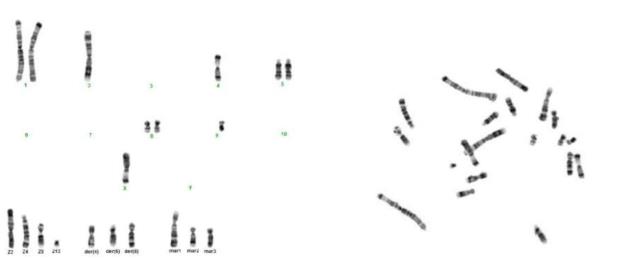BHK-21 Cell Chromosomal Aberration Analysis
BHK-21 cell line is a continuous cell line used to propagate foot-and-mouth disease (FMD) virus for vaccine manufacturing. However, BHK-21 cell line instability can affect cell culture phenotypes such as cell growth, productivity, or product quality and remain challenges for biopharmaceutical manufacturing.
Karyotype analysis (G-Banded analysis) can indicate that BHK-21 cells, as well as limiting-diluted subclones, exhibit a karyotypically heterogeneous population, suggesting that chromosomal rearrangements occur spontaneously and frequently even in non-engineered host cells. This technique used to characterize the cell bank genetic instability would be evaluated as a tool for the detection of instability in cell line development processes. BHK-21 cell line stability issues challenge biopharmaceutical manufacturing. Here, Creative Bioarray has established BHK-21 Cell Chromosomal Aberration Analysis to fast-track your stable cell line stability and accelerate subsequent IND review.
 Figure 1. BHK-21 Karyotype generated from BHK-21 cultured cells. Spread #10 of (left half) with its corres ponding karyotype (right half). Chromosome complement: 20 chromosomes (mainline karyotype plus extra copy of Chromosome 8).
Figure 1. BHK-21 Karyotype generated from BHK-21 cultured cells. Spread #10 of (left half) with its corres ponding karyotype (right half). Chromosome complement: 20 chromosomes (mainline karyotype plus extra copy of Chromosome 8).
The Service Features:
Creative Bioarray's BHK-21 Cell Chromosomal Aberration Analysis has the following features:
- Metaphase nuclei harvest and chromosome count.
- Chromosomal abnormality quantification.
- Counting: 30-40 cells, and microscope analysis of 20 metaphase spreads.
- Standard cytogenetic analysis can be customized to your need.
Quotation and ordering
Our customer service representatives are available 24hr a day! We thank you for considering Creative Bioarray as your BHK-21 Cell Chromosomal Aberration Analysis Service partner.
References
- Frye, C.; Deshpande, R.; Estes, S.; Francissen, K.; Joly, J.; Lubiniecki, A.; Munro, T.; Russel, R.; Wang, T.; Anderson, K. Industry view on the relative importance of “clonality” of biopharmaceutical-producing cell lines. Biologicals 2016, 44, 117–122.
- Puck, T.T. The genetics of somatic mammalian cells. Adv. Biol. Med. Phys. 1957, 5, 75–101.
- Gottesman, M.M. Mammalian Cell Genetics; John Wiley and Sons: New York, NY, USA, 1985.
- Binz, Regina L., et al. "Identification of novel breakpoints for locus-and region-specific translocations in 293 cells by molecular cytogenetics before and after irradiation." Scientific reports 9.1 (2019): 10554.
All products and services on this website are only suitable for non-medical purposes.


 Figure 1. BHK-21 Karyotype generated from BHK-21 cultured cells. Spread #10 of (left half) with its corres ponding karyotype (right half). Chromosome complement: 20 chromosomes (mainline karyotype plus extra copy of Chromosome 8).
Figure 1. BHK-21 Karyotype generated from BHK-21 cultured cells. Spread #10 of (left half) with its corres ponding karyotype (right half). Chromosome complement: 20 chromosomes (mainline karyotype plus extra copy of Chromosome 8).


